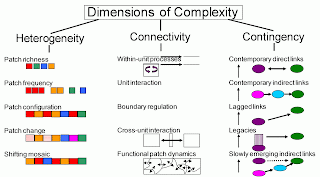Complexity: The Hidden Nugget in Jane Jacobs’ Book
Well, perhaps it’s unfair to call it hidden. It is after all the topic of the final chapter, entitled “The Kind of Problem a City Is.” In that chapter, she explores the nature of cities as complex systems, stimulated by the work of pioneering cyberneticists as summarized by Dr. Warren Weaver[i]. But I have to admit that I missed it the first time around, back when I read Jane Jacobs’ Death and Life of Great American Cities in college. (No, you may no ask what century that was!) But I can perhaps be forgiven for the lapse, because the theory of complex adaptive systems, which has become a mainstay of ecological sciences in the past decade or so, was hardly well known back then. (OK, it was around 1970 when I read Death and Life.) Yes, some physical scientists and mathematicians were in on complexity, but it was not something that had sent its tendrils into many other disciplines at that time. Now we have a journal of Biocomplexity, and the National Science Foundation has made grants in complexity and similar things, such as coupled natural-human systems, for over a decade.
 |
| Jane Jacobs (from http://www.whatwesee.org/) |
Two recent reminders highlight Jane Jacobs’ insight that cities are complex problems. In 2010, I was on a Martin Luther King Fellowship at the Massachusetts Institute of Technology in the Department of Urban Studies and Planning. My host, the ecologically savvy landscape architect, Anne Whiston Spirn[ii] mentioned to me one day that she had been horrified to have exploited the significance of Jacobs’ final chapter on cities as complex systems. I went back and read that last chapter again. It is a stunningly prescient piece.
The second reminder is in Witold Rybczynski’s Makeshift Metropolis: Ideas About Cities, published in 2010 by Scribner. Rybczynski is one of America’s best known urbanists, and a writer whose work is easy to read. In chapter 2, he reviews the three big ideas of urbanism from the early 20th century[iii], and notes, among others, Jacobs’ critique of all of them. His reminder came toward the end of the chapter, where he points to her assessment of cities as complex systems, and quotes some of her pithier insights into urban complexity. Cities should not be approached as sets of separate problems to be solved individually. They are complex wholes, but only because of the interaction of a plethora of communities and processes.
To be sure, Rybczynski (OK, I’m calling him WR from now on) has criticisms of Jacobs. She was, after all, originally a journalist and not a trained urban scholar. One important criticism is that she, like many other urbanists, has perhaps made a bit too much of physical characteristics such as density, diversity of use, and pedestrian vigilance. WR notes that at the same time she was extolling the values of these characteristics based on her own experience, especially in New York City’s Greenwich Village, Lewis Mumford cited other New York neighborhoods possessing these same characteristics as notoriously unsafe and crime ridden. WR also notes that some of her criticisms, such as the City Beautiful movement being only about civic monuments, and not about incremental improvement in neighborhoods, were incorrect.
These musings are relevant to the theme of the third phase of the Baltimore Ecosystem Study LTER: the transition from the sanitary to the sustainable city. The sanitary city is merely complicated. It is seen as a collection of individual problems to be individually solved. In reality, the problems that cities have to solve are systemic. They link across media of transport, such as air, water, and surface, across scales from households to regions, and across social and environmental realms, for example. It is not sufficient to solve problems by discipline – parks for the trees, transportation for traffic flow, solid waste, storm water, sanitary sewers, etc. Each of these issues has implications for the other, and in fact, each has energy or material flows that connect with others. The sustainably city goal recognizes cities as complex systems and the solution of urban problems to be multifaceted and require integration across disciplines and existing bureaucracies. Jane Jacobs was there in 1961.
My meanderings in this essay have three points. First, Jane Jacobs was ahead of her time in proposing cities as something we would now call complex adaptive systems. She called them complex problems. Second, a re-reading of Jacobs is worthwhile. Finally, Rybczynski’s new book on the Makeshift Metropolis should probably be the next BES Book of the Month. I’d recommend it to all members of our program, and others interested in urban systems.
 |
| Dimensions of complexity (from Cadenasso et al. 2006) |
There’s one more thing to say about Jane Jacobs as an exemplar for BES. She took fine scale observation of the city seriously. She did not approach the city with the goal of supporting a specific general theory of urbanism, but to understand how cities were structured and how they worked. She was a consummate empiricist, and her insistent observations have contributed to new theories of the city.
[i] Familiar to ecologists through the Shannon-Weaver diversity index, which is based on information theory, one approach to complexity.
[ii] http://www.annewhistonspirn.com/
[iii] These are 1) the City Beautiful, 2) the Garden City, and 3) the Radiant City.
References:
Cadenasso, M. L., S. T. A. Pickett, and J. M. Grove. 2006. Dimensions of ecosystem complexity: heterogeneity, connectivity, and history. Ecological Complexity 3:1-12.


